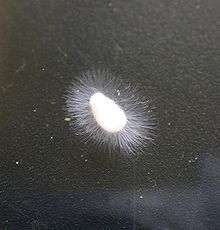Pseudofungi
Pseudofungi is a grouping of heterokonts,[2][3] also known as the Heterokontimycotina.[4] It consists of the Oomycota and Hyphochytridiomycetes.[4] Although numerous biochemical, ultrastructural, and genetic traits clearly place them in the heterokonts, their growth form (featuring hyphae) and mode of nutrition (osmotrophy) resemble that of fungi (which are not closely related).[4]
| Pseudofungi | |
|---|---|
 | |
| Achlya sp. growing on a hemp seed | |
| Scientific classification | |
| Domain: | Eukaryota |
| (unranked): | Bikonta |
| (unranked): | Chromalveolata |
| Phylum: | Heterokontophyta |
| (unranked): | Pseudofungi Cavalier-Smith, 1986[1] |
| Groups | |
| Synonyms | |
|
Heterokontimycotina M.W. Dick, 1976 | |
Origin and ancestors
It is believed that pseudofungi descend from unicellular heterokont chromist algae which lost their plastids. While evidence of these plastids hasn't been found, what has been proven is the existence of endosymbiotic red algae plastids.[5] From this, a unicellular heterotroph proto-pseudofungi (probably a mushroom parasite) got its fungal genes through horizontal gene transfer, which would have led to the development of convergent fungal multicellularity,[6] explaining why the cell wall is sometimes made of both chitin and cellulose. The group's interrelationships are as follows:
| Pseudofungi |
| ||||||||||||
References
- Prog. Phycol. Res. 4: 341, 1986.
- Riisberg I, Orr RJ, Kluge R, et al. (May 2009). "Seven gene phylogeny of heterokonts". Protist. 160 (2): 191–204. doi:10.1016/j.protis.2008.11.004. PMID 19213601.
- Cavalier-Smith T, Chao EE (April 2006). "Phylogeny and megasystematics of phagotrophic heterokonts (kingdom Chromista)". J. Mol. Evol. 62 (4): 388–420. Bibcode:2006JMolE..62..388C. doi:10.1007/s00239-004-0353-8. PMID 16557340.
- Van der Auwera G, De Baere R, Van de Peer Y, De Rijk P, Van den Broeck I, De Wachter R (July 1995). "The phylogeny of the Hyphochytriomycota as deduced from ribosomal RNA sequences of Hyphochytrium catenoides". Mol. Biol. Evol. 12 (4): 671–8. doi:10.1093/oxfordjournals.molbev.a040245. PMID 7659021.
- Richards TA, Talbot NJ (2007). "Plant parasitic oomycetes such as phytophthora species contain genes derived from three eukaryotic lineages". Plant Signal Behav. 2 (2): 112–4. doi:10.4161/psb.2.2.3640. PMC 2633911. PMID 19704752.
- Richards TA, Dacks JB, Jenkinson JM, Thornton CR, Talbot NJ (2006). "Evolution of filamentous plant pathogens: gene exchange across eukaryotic kingdoms". Curr. Biol. 16 (18): 1857–64. doi:10.1016/j.cub.2006.07.052. PMID 16979565.